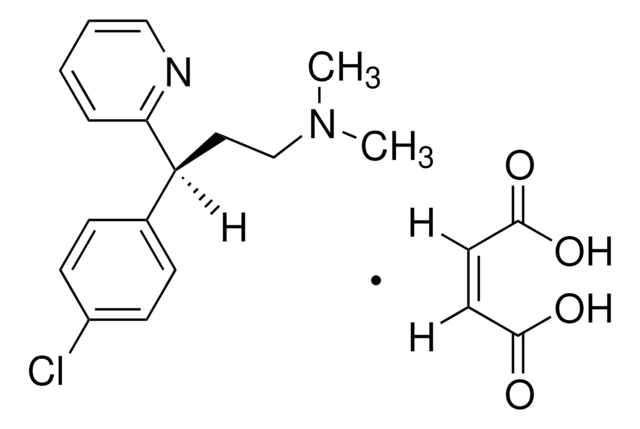Wichtige Dokumente
C4915
S-(+)-Chlorpheniramin -maleat (Salz)
Synonym(e):
(S)-γ-(4-Chlorphenyl)-N,N-dimethyl-2-pyridinpropanamin -maleat (Salz)
About This Item
Empfohlene Produkte
Form
powder
Qualitätsniveau
Ersteller
Bayer
SMILES String
[H]\C(=C(/[H])C(O)=O)C(O)=O.CN(C)CC[C@@H](c1ccc(Cl)cc1)c2ccccn2
InChI
1S/C16H19ClN2.C4H4O4/c1-19(2)12-10-15(16-5-3-4-11-18-16)13-6-8-14(17)9-7-13;5-3(6)1-2-4(7)8/h3-9,11,15H,10,12H2,1-2H3;1-2H,(H,5,6)(H,7,8)/b;2-1-/t15-;/m0./s1
InChIKey
DBAKFASWICGISY-DASCVMRKSA-N
Angaben zum Gen
human ... HRH1(3269)
Suchen Sie nach ähnlichen Produkten? Aufrufen Leitfaden zum Produktvergleich
Allgemeine Beschreibung
Anwendung
Biochem./physiol. Wirkung
Chlorpheniramine maleate is clinically used as a topical ointment to treat skin disorders such as sunburn, urticaria, angioedema, pruritus and insect bites.
Leistungsmerkmale und Vorteile
Anwendung
Ähnliches Produkt
Signalwort
Danger
H-Sätze
Gefahreneinstufungen
Acute Tox. 3 Oral
Lagerklassenschlüssel
6.1C - Combustible acute toxic Cat.3 / toxic compounds or compounds which causing chronic effects
WGK
WGK 3
Flammpunkt (°F)
Not applicable
Flammpunkt (°C)
Not applicable
Persönliche Schutzausrüstung
Eyeshields, Faceshields, Gloves, type P2 (EN 143) respirator cartridges
Analysenzertifikate (COA)
Suchen Sie nach Analysenzertifikate (COA), indem Sie die Lot-/Chargennummer des Produkts eingeben. Lot- und Chargennummern sind auf dem Produktetikett hinter den Wörtern ‘Lot’ oder ‘Batch’ (Lot oder Charge) zu finden.
Besitzen Sie dieses Produkt bereits?
In der Dokumentenbibliothek finden Sie die Dokumentation zu den Produkten, die Sie kürzlich erworben haben.
Chromatograms
application for HPLCapplication for SFCUnser Team von Wissenschaftlern verfügt über Erfahrung in allen Forschungsbereichen einschließlich Life Science, Materialwissenschaften, chemischer Synthese, Chromatographie, Analytik und vielen mehr..
Setzen Sie sich mit dem technischen Dienst in Verbindung.





